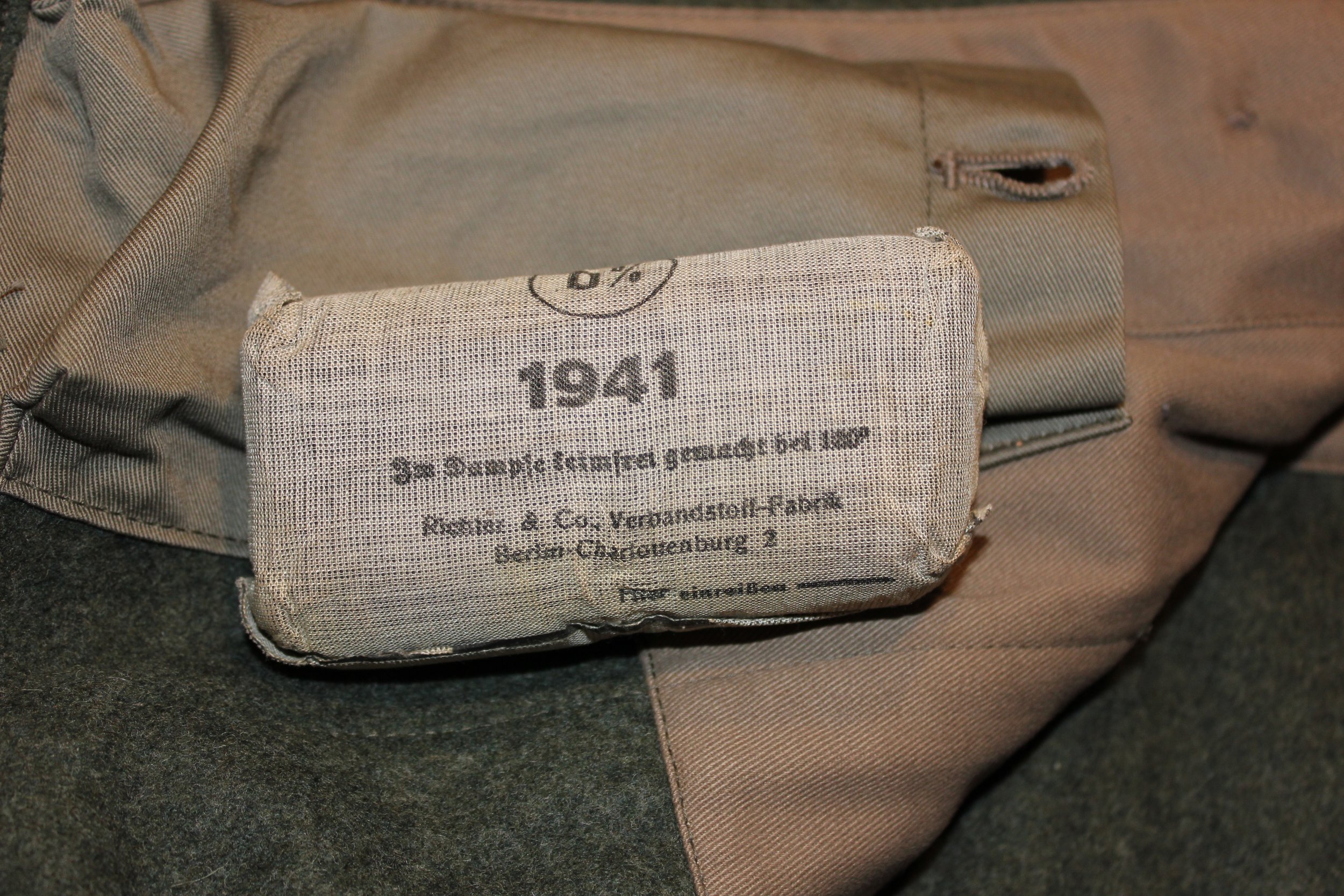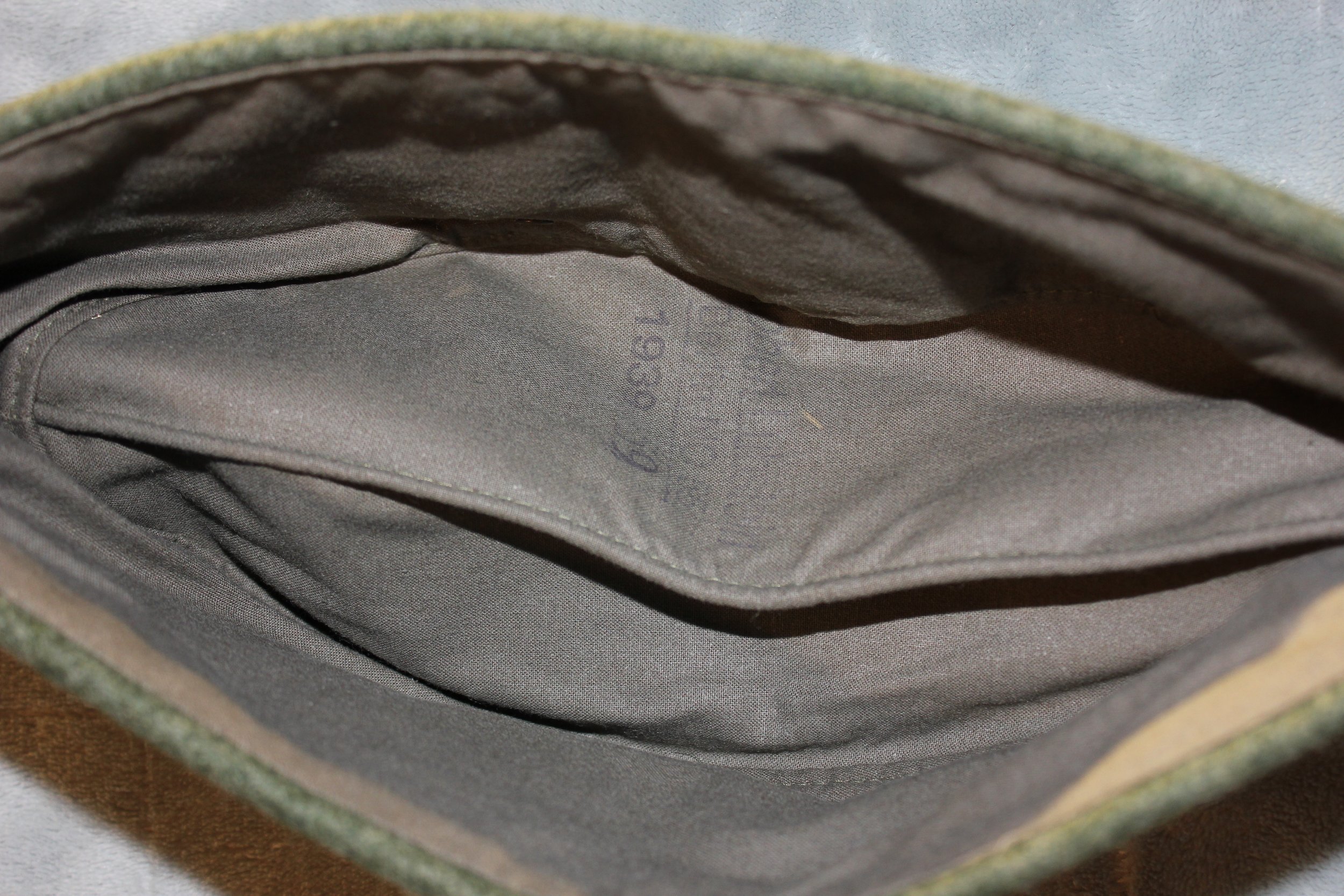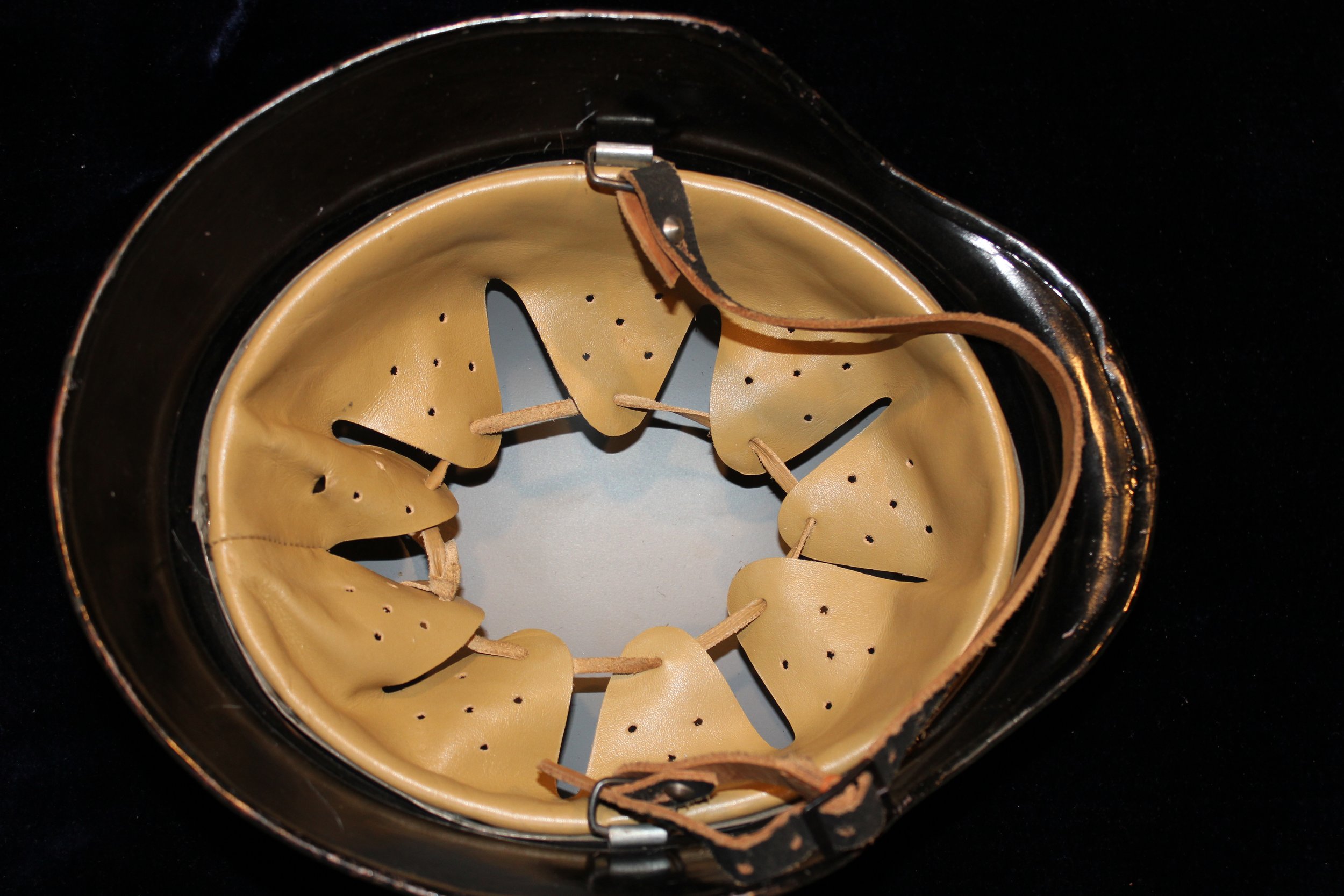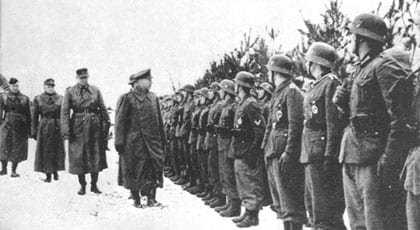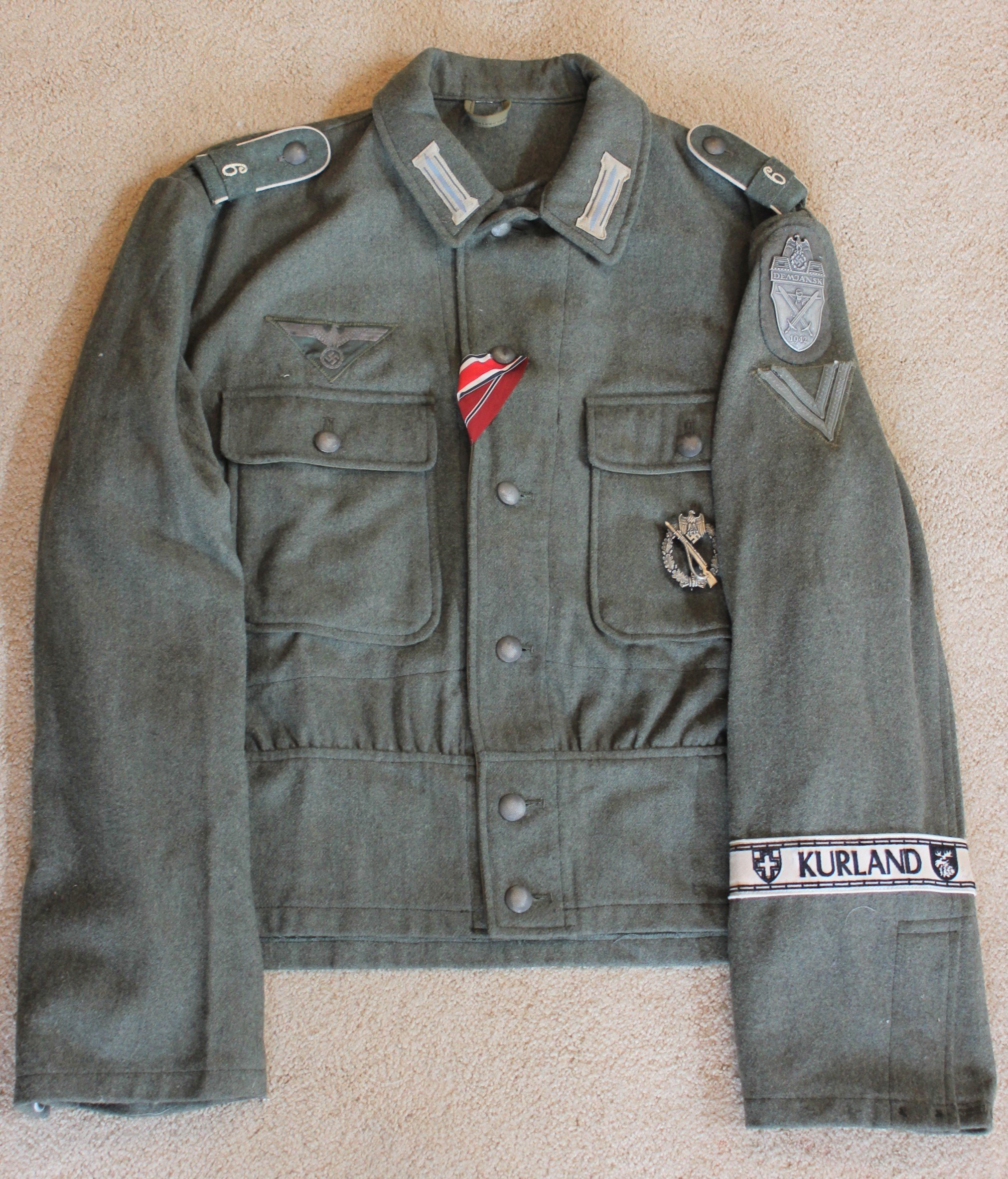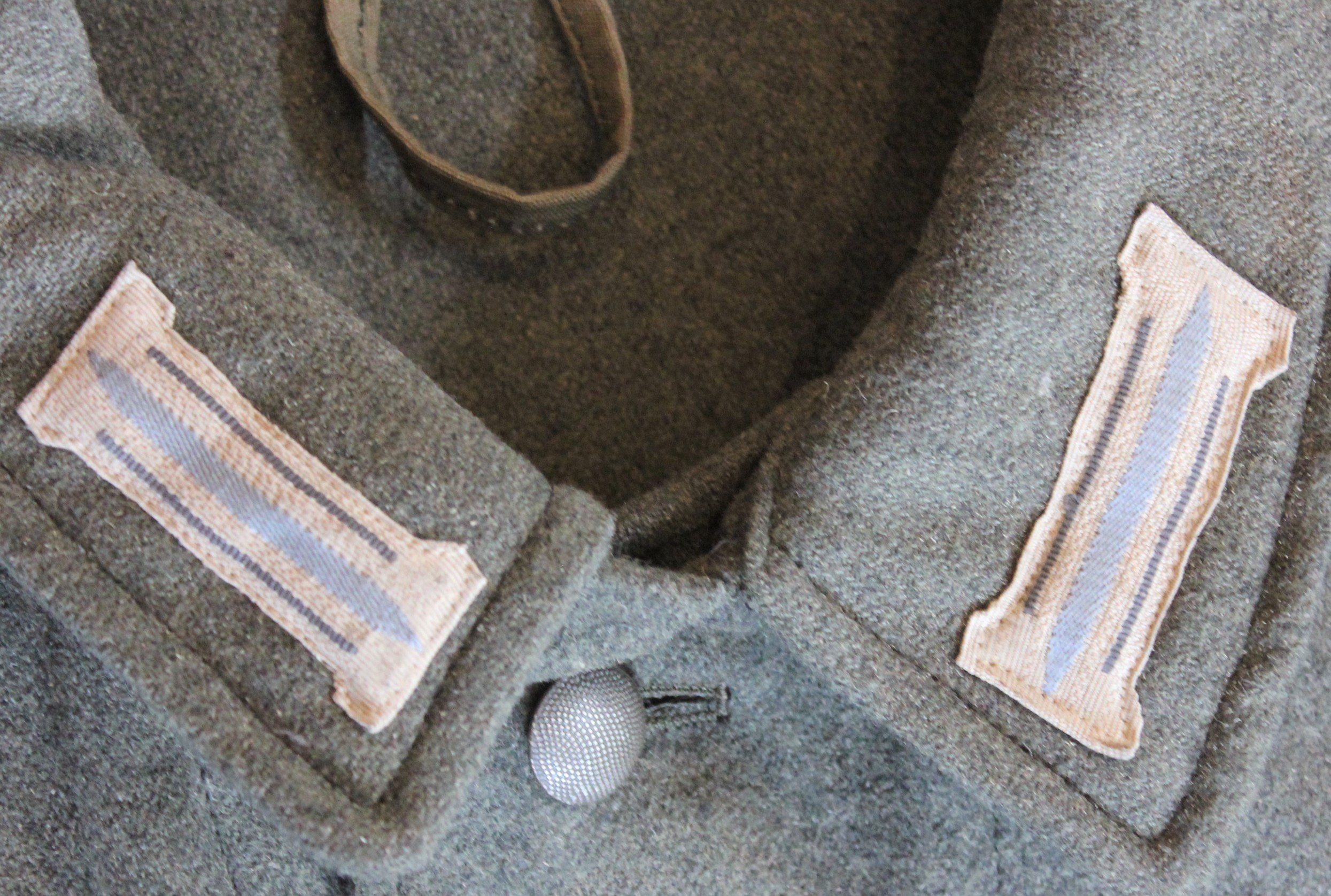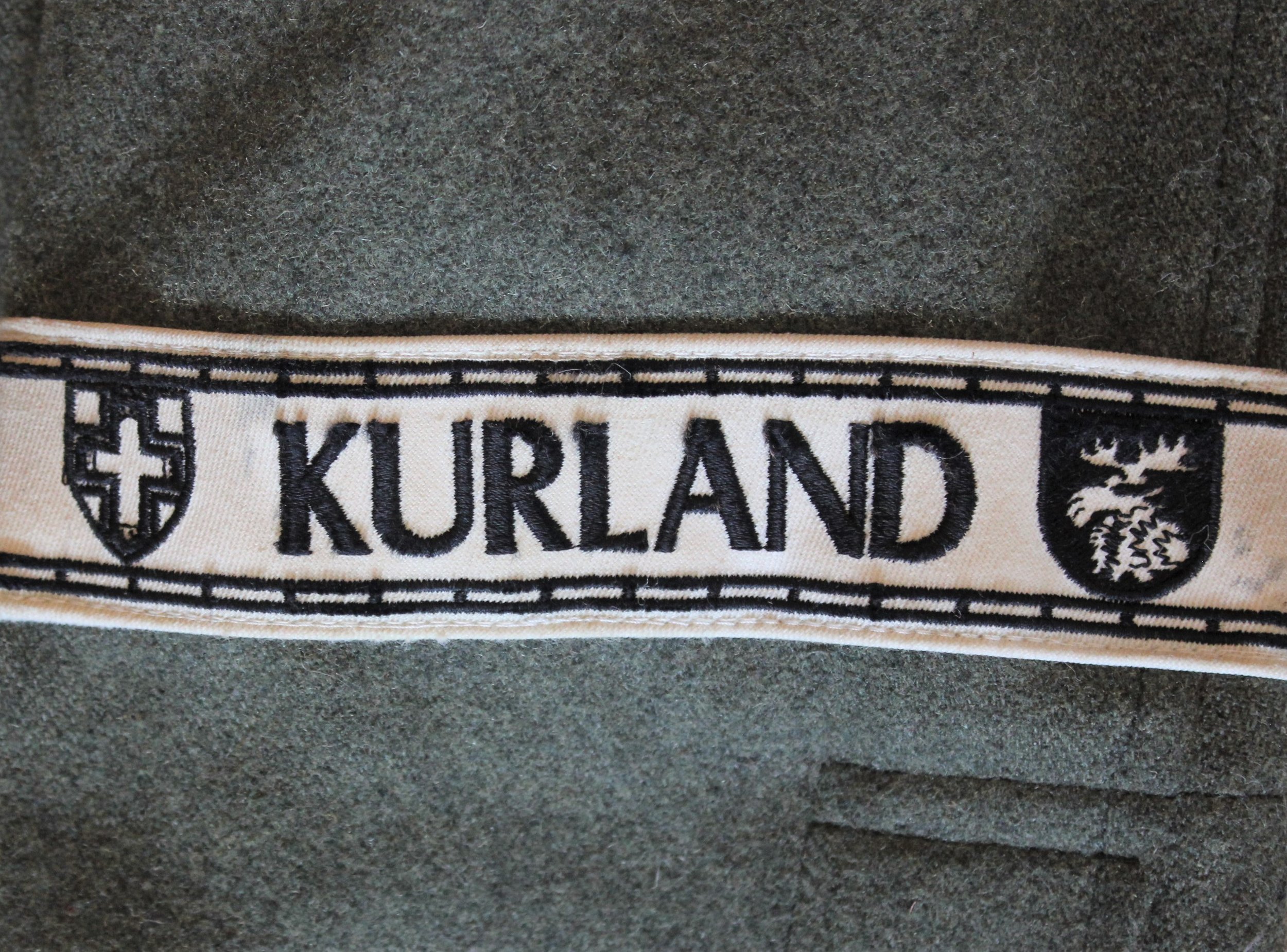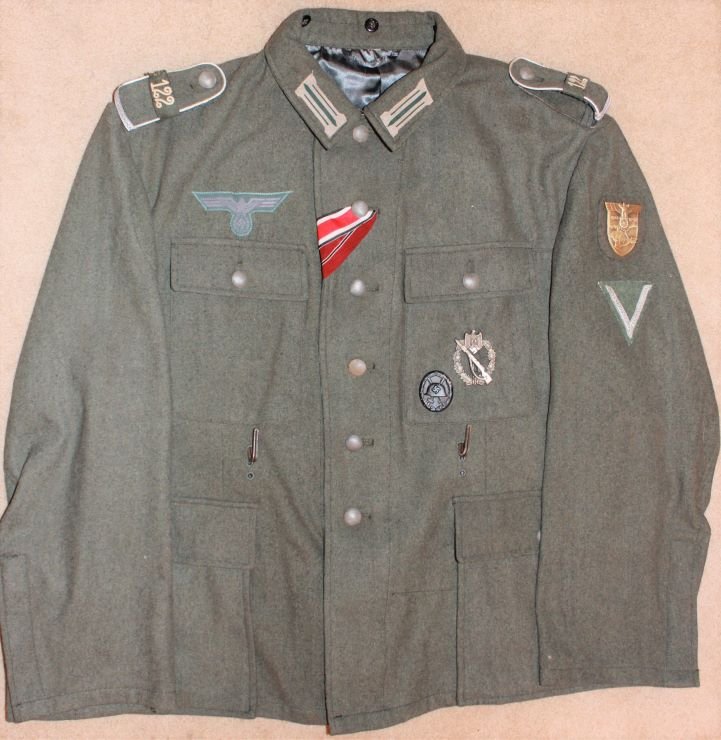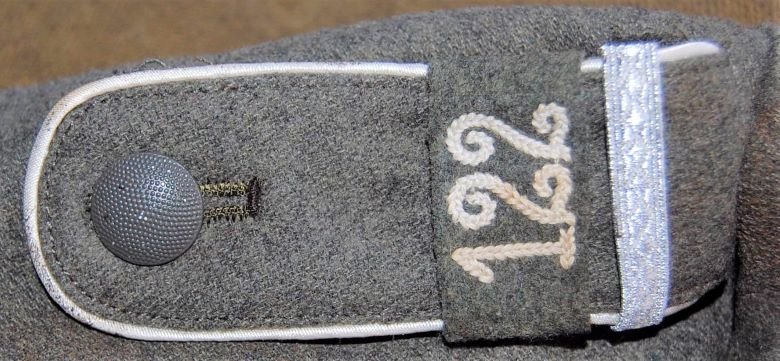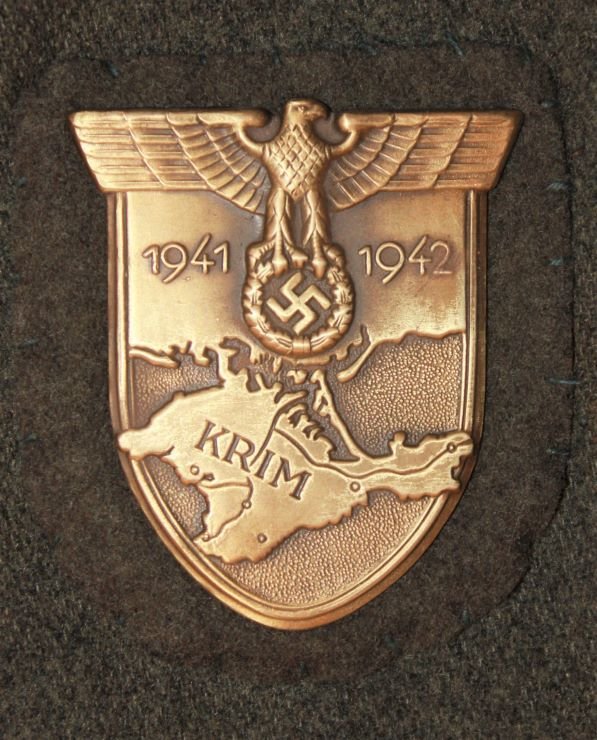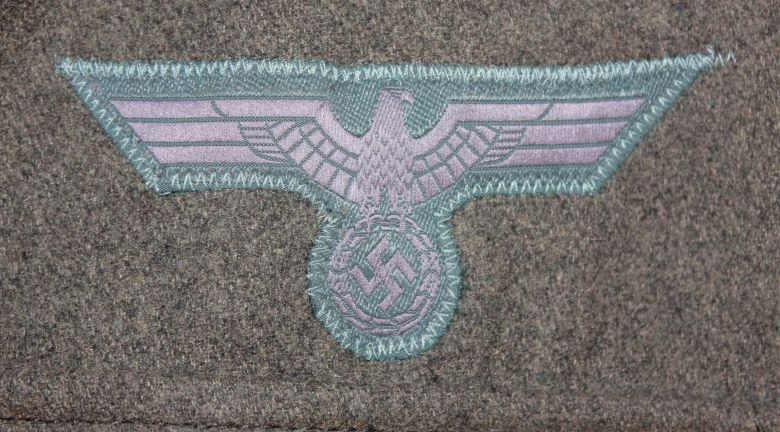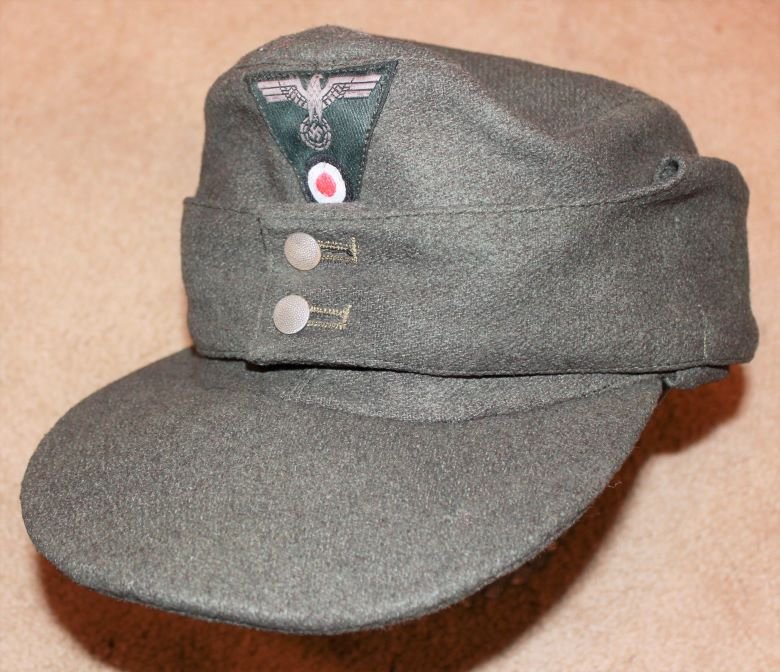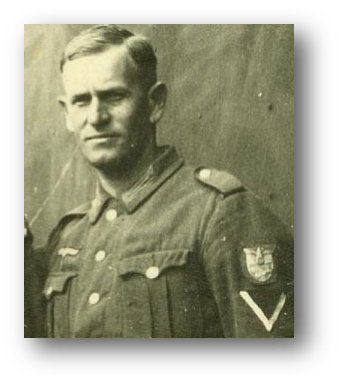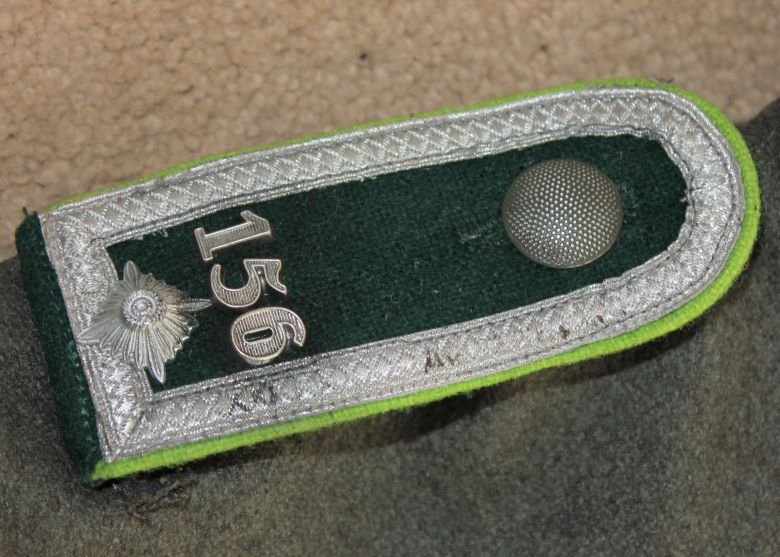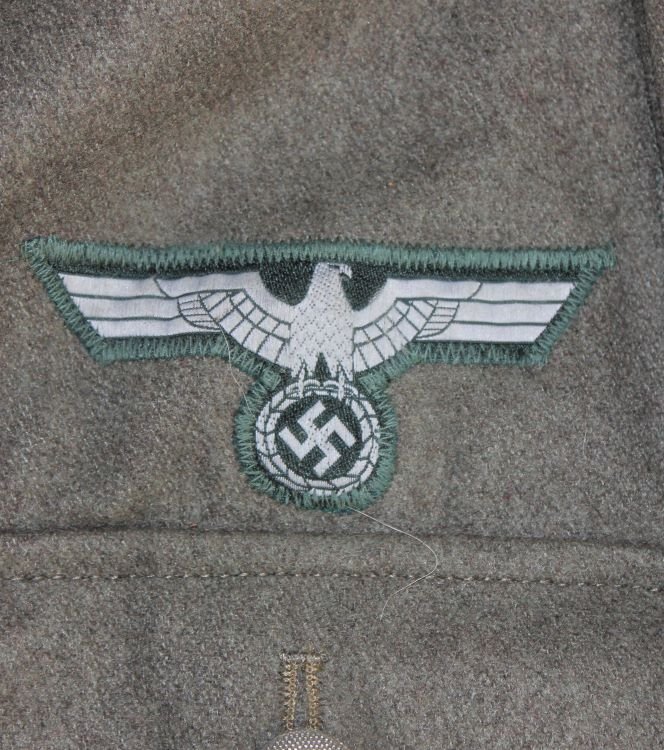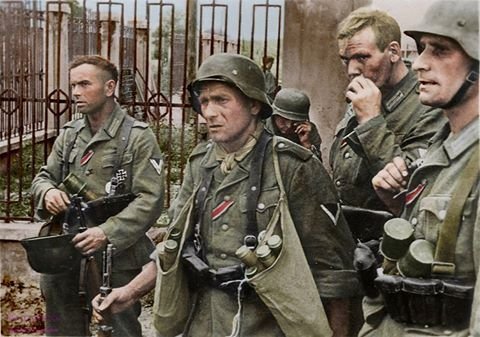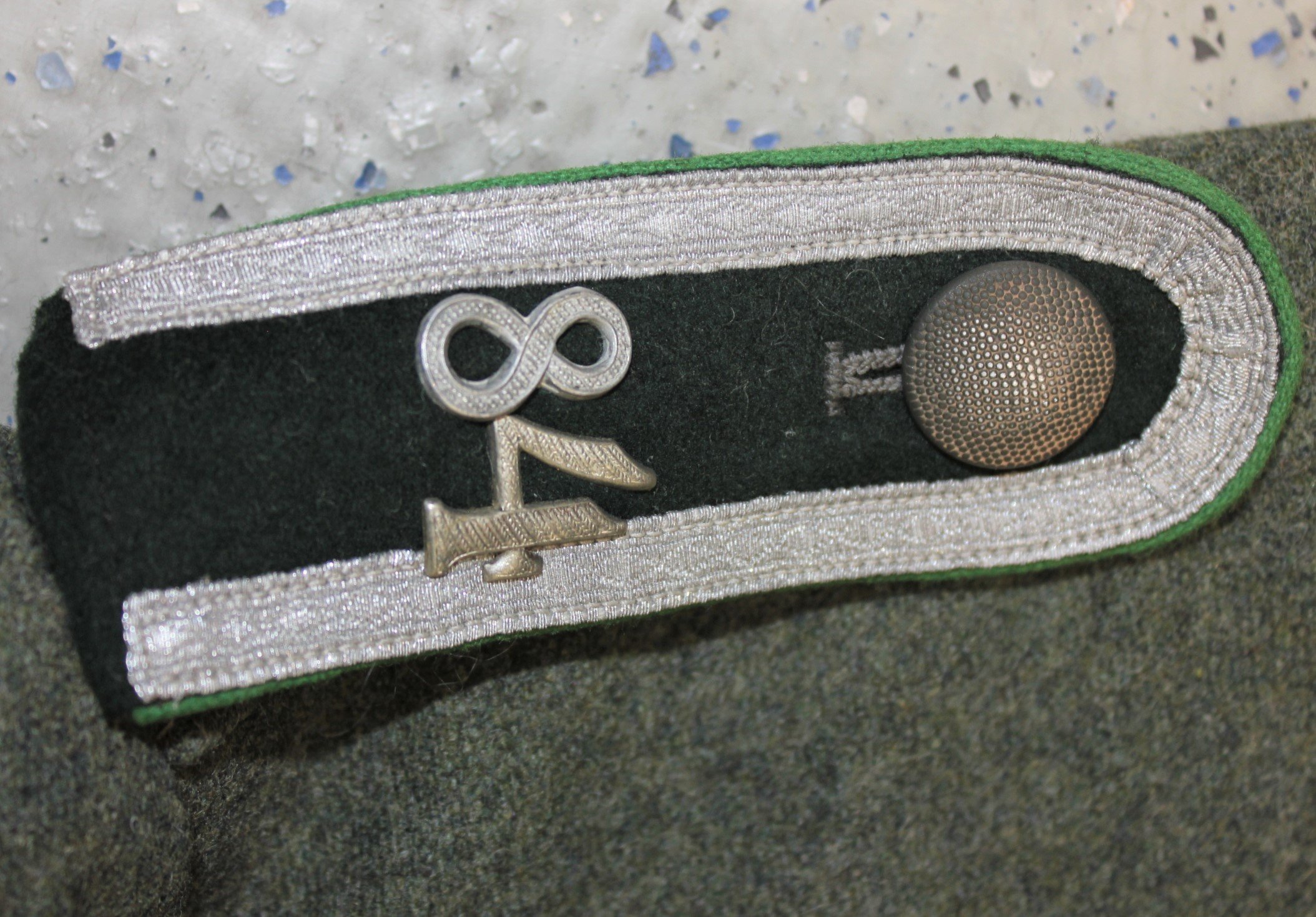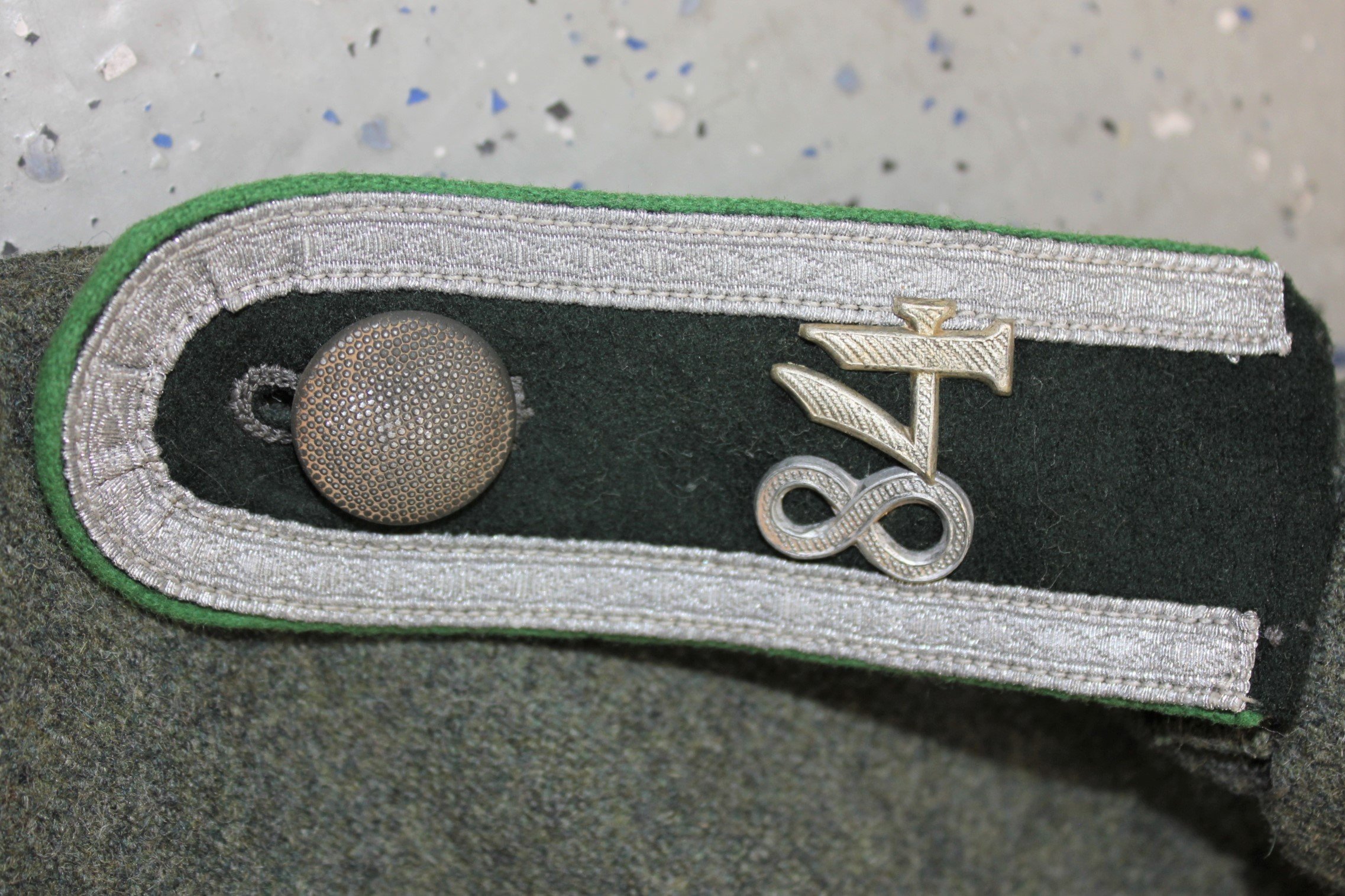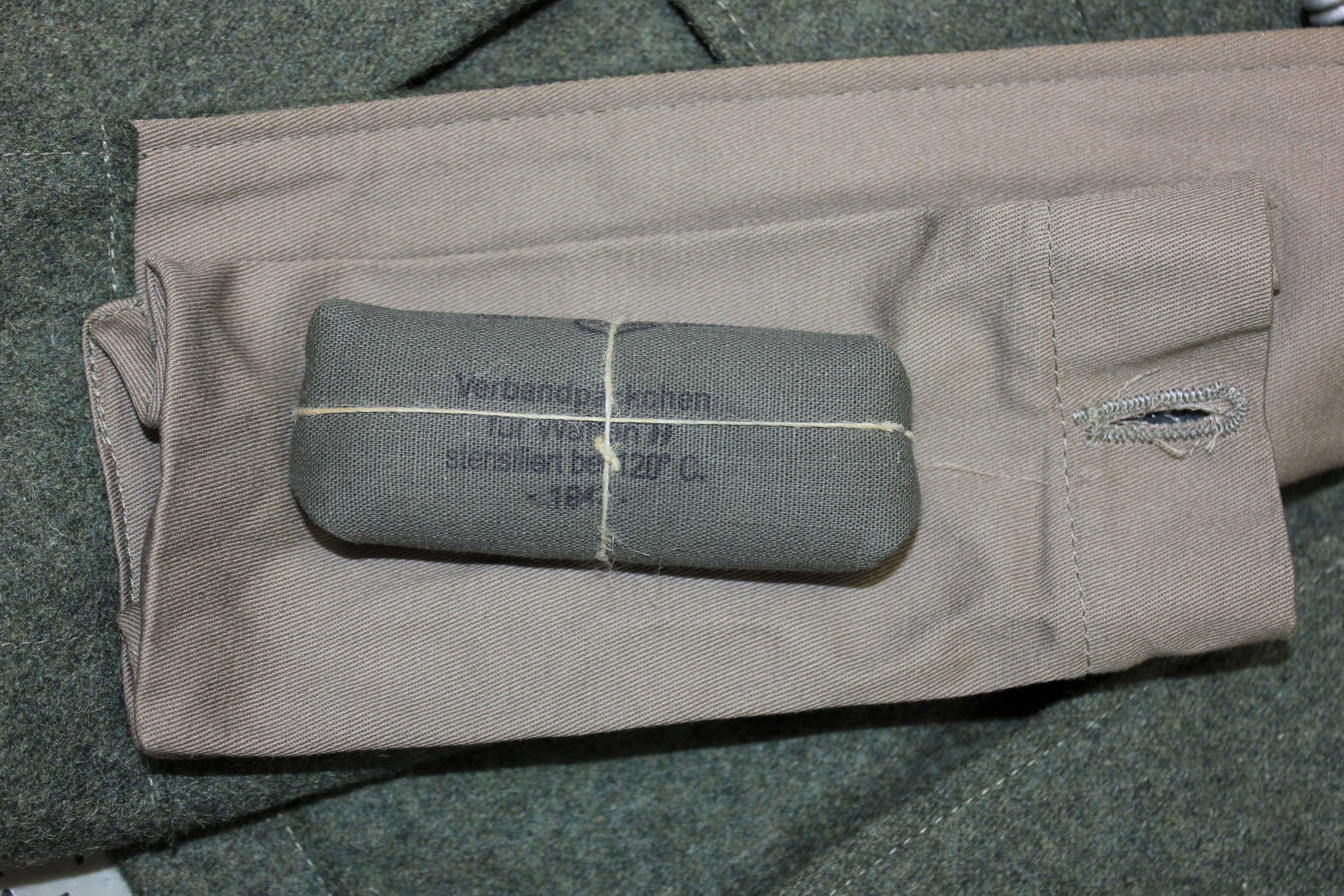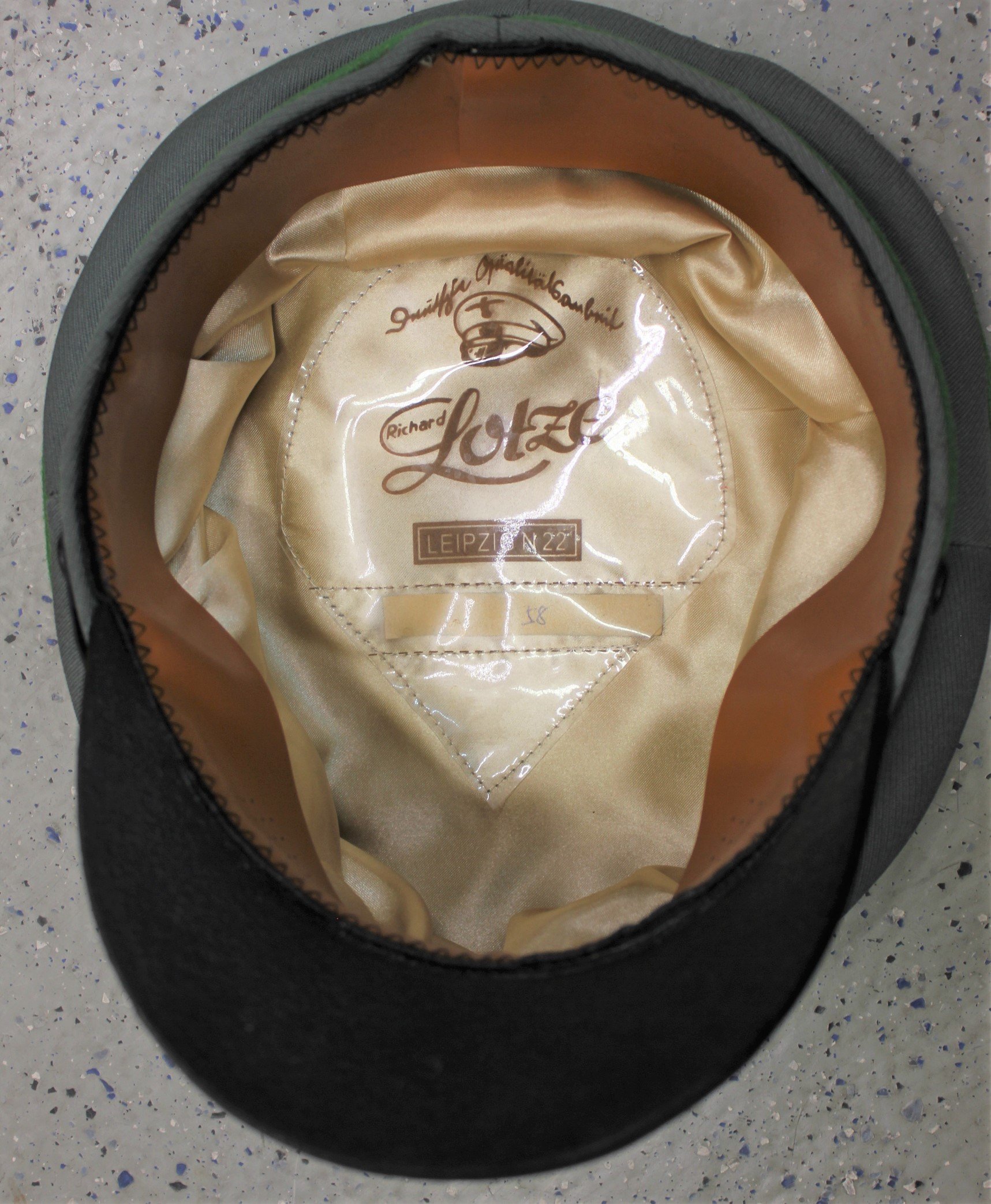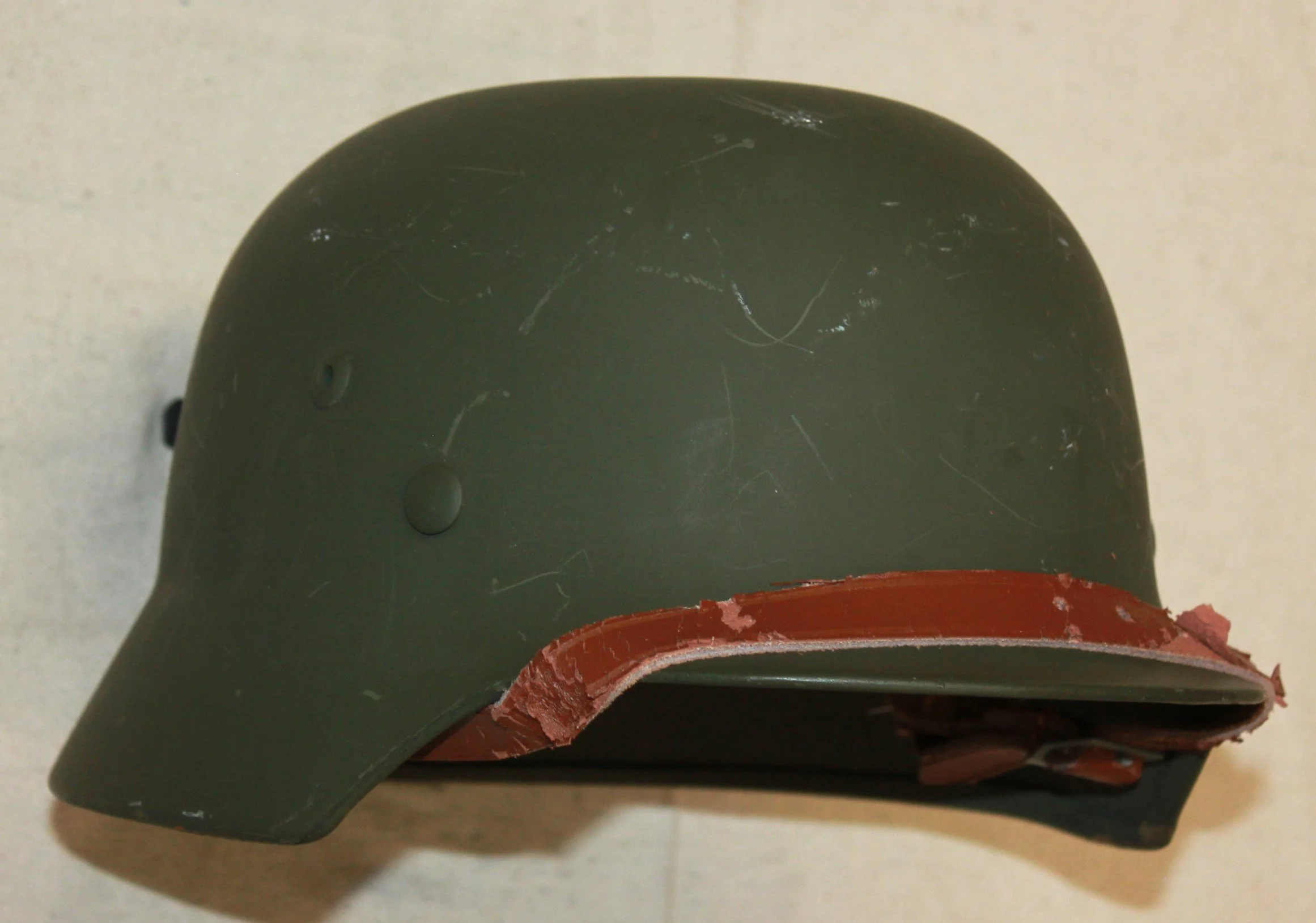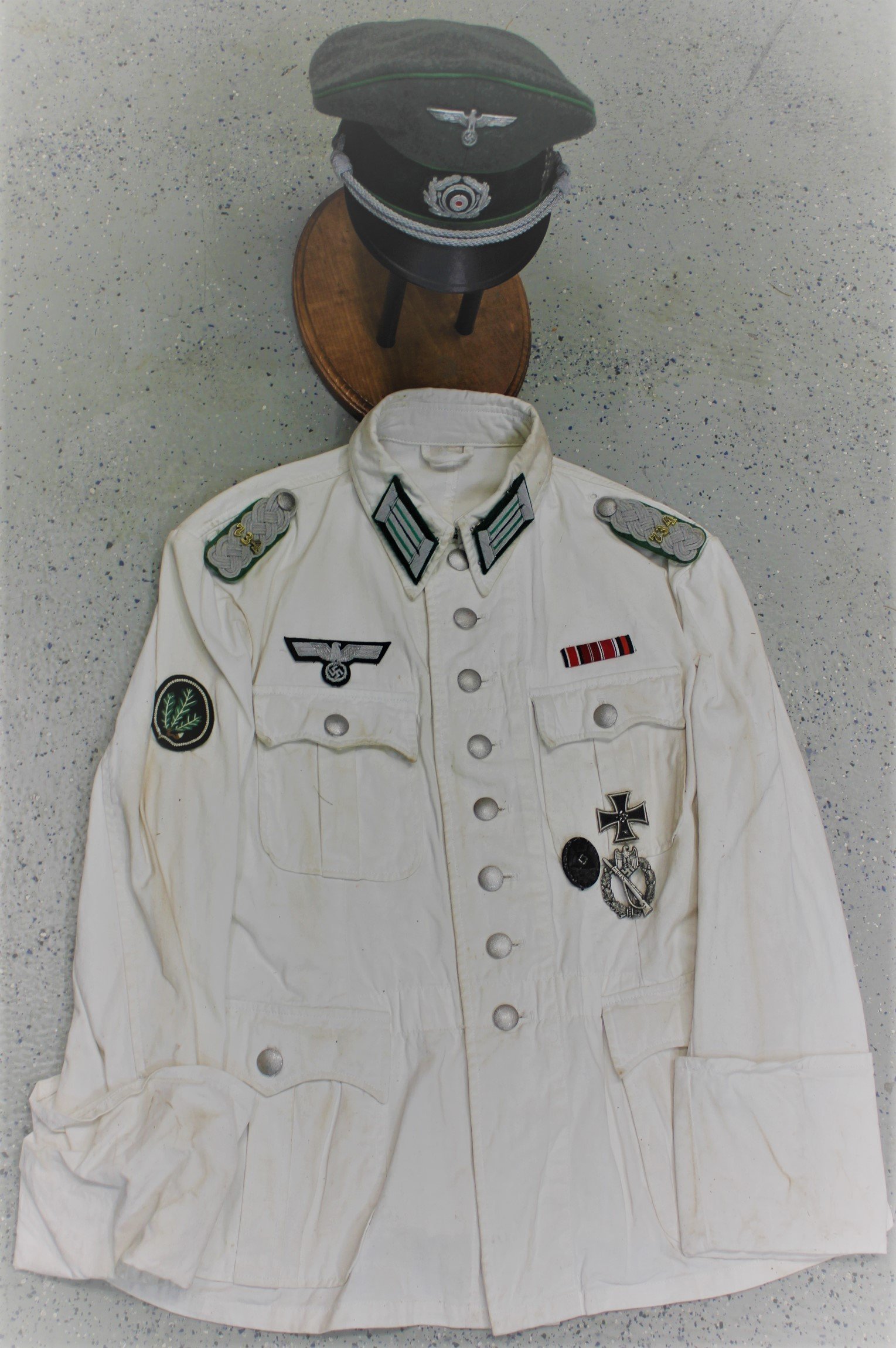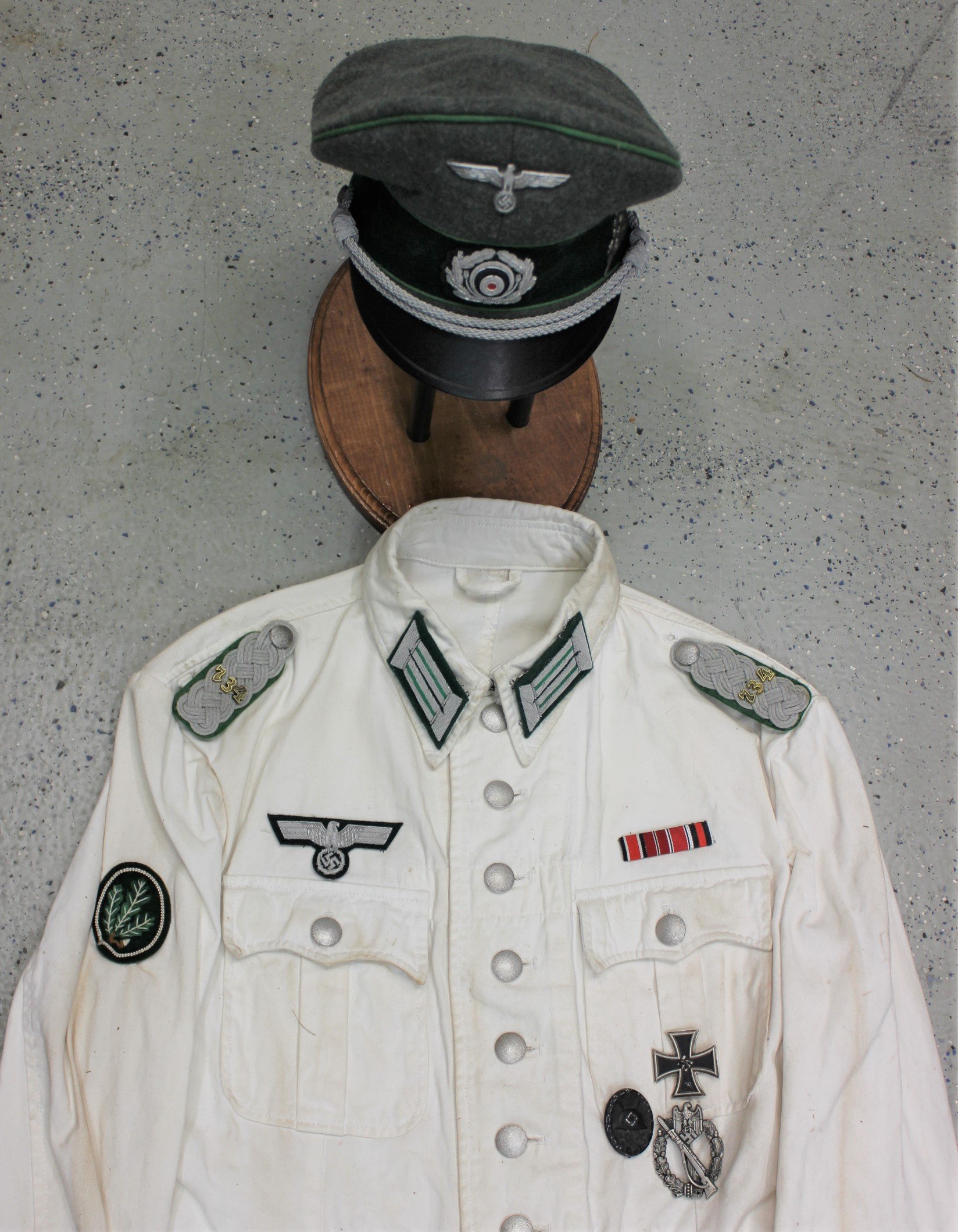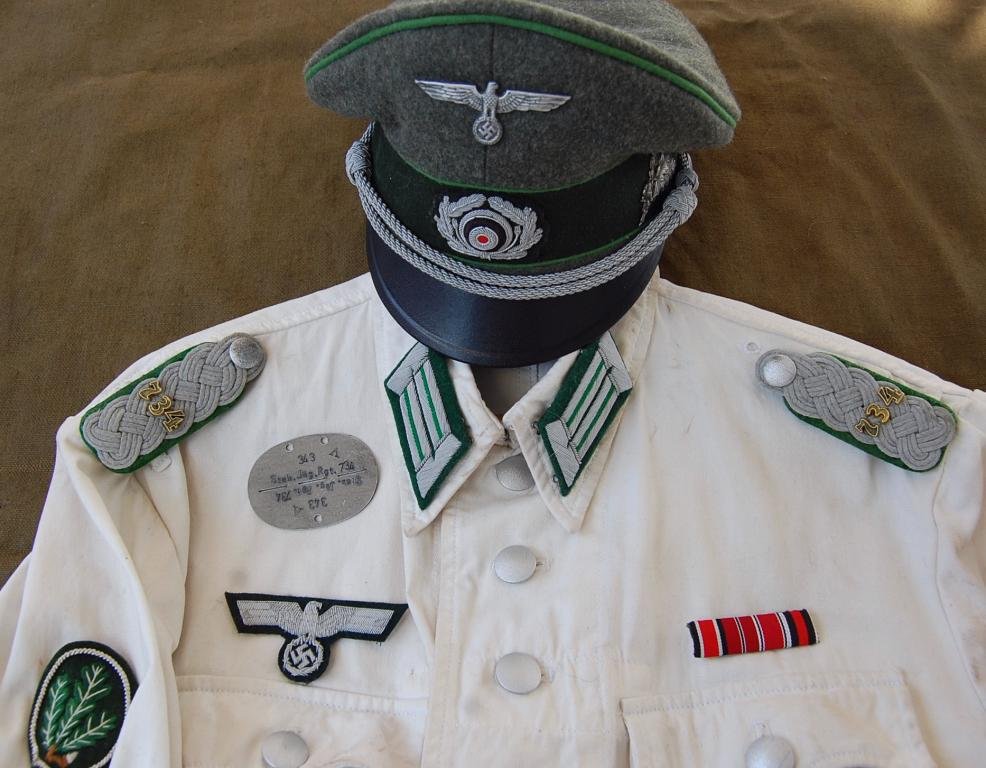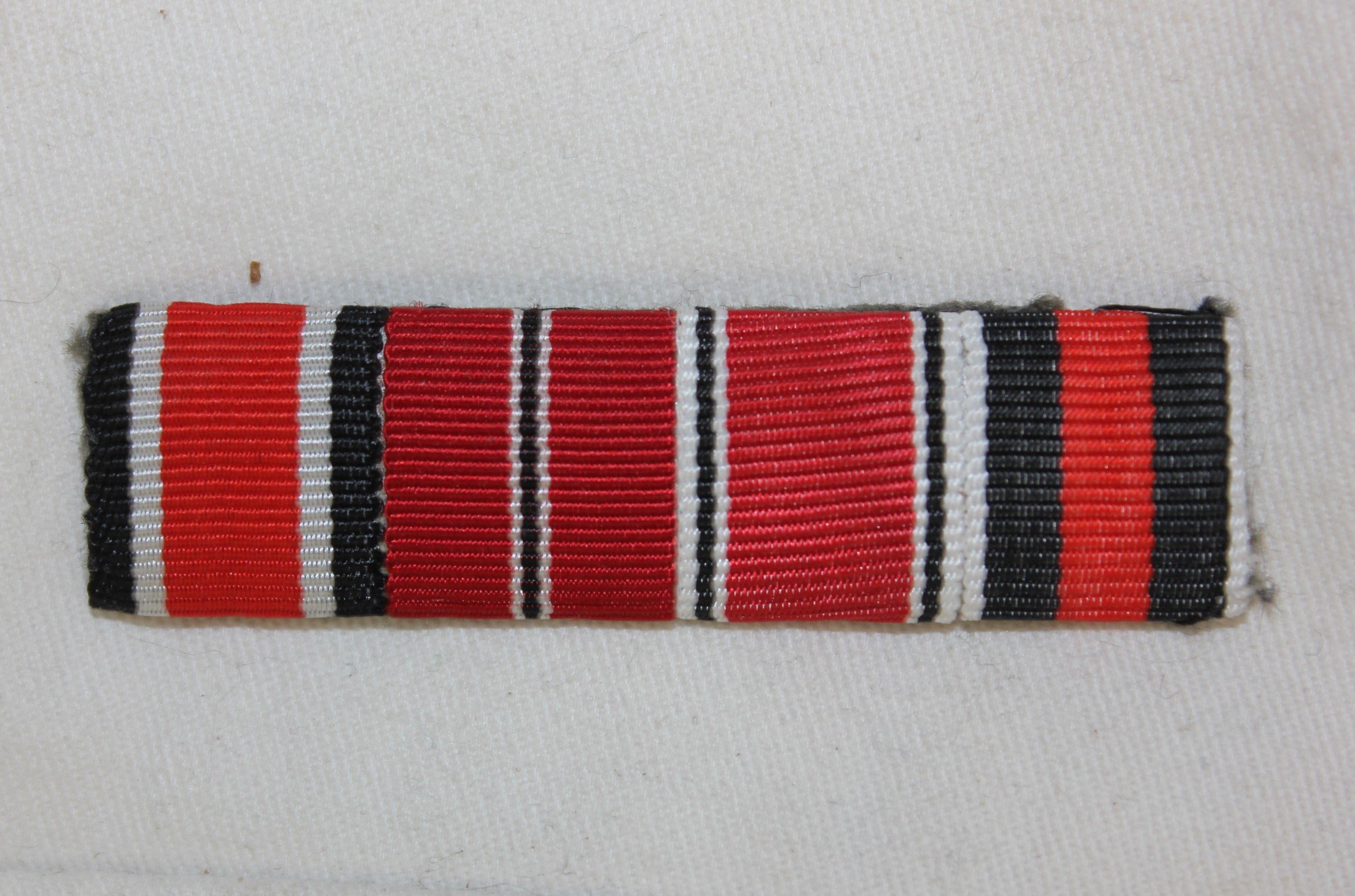Heer Jager & Grenadier:
*Ritterkreuztrager Franz Gossmann 2. / Grenadier Regiment 199 “List”, “Der Speiss” :
Franz Gossmann was a highly decorated Oberfeldwebel and Spähe of 2. Kompanie / Grenadier Regiment 199, “List”. Gossmann fought on the Eastern Front with the same outfit for his time in the war, with G.R. 199, with the only exception to the times he was recovering from different wounds.
He received the “Verwundabzeichen in Gold” in February 1945. Gossmann’s combat leadership was recognized, and he received the awards of the Eisernkreuz II Klasse in 1941, the I Klasse in 1942, the Deutsche Kreuz in Gold in 1943, and the Ritterkreuz in 1944. A frontline combat leader, Gossmann was one of only 631 winners of the Nakampfspange in Gold.
In late 1944, Grenadier-Regiment 19 was the “Inheritor” of the regimental traditions of the disbanded Infantry Regiment of the 57. Infantry-Division. It was given the horrific title of “Infantrie-Regiment List,” which denoted that the regiment carried on the traditions of the original Imperial Bavarian Regiment 16, in which Hitler had served as Gefreiter during WWI.
Members of Grenadier Regiment 19 were allowed a “Cuff-Title” on their Left sleeve (a 2.3cm dark-green band with gray with white edging (so-called Copper-Plate” Style lettering) in the words “Infantrie-Regiment List” It was one of the very few Heer Regiments so entitled.
Gossmann wears the standard M36 Feldbluse with enlisted Schirmmutz in his official “Ritterkreuztrager” photo. At this point, he had yet to earn the Verwundabzeichen in Gold. He has an NCO Grade wire BEVO National-Eagle on the blues as well as the “Speiss” Cuff Stripes. With the uniform, he wore standard-issue trousers and a cartridge belt, with an enlisted belt buckle.
*This uniform is part of a set of two; the other is in (Part One) German Heer Infantry, section.
Hauptfeldwebel, “Michael Moser”, Kompanie Speiß, 4./ Infanterie Regiment 199 “List”:
A converted Heeres Dienstanzug Model 1943, this uniform is shown clearly in several period photos in Hauptfeldwebel Moser’s album. He was awarded the Ost Front medal in 1942, the Kriegsverdienst Kreuz in 1943, and the Infanterie-Sturmabzeichen in 1944. The 57. Infanterie-Division was formed in August 1939 as part of the 2. Welle or wave of the German rearmament.
The division fought in Poland and France before being sent east for Operation Barbarossa as part of the XLVIII Panzerkorps as part of Armeegruppe Süd. After fighting at Kursk and breaking out of the Cherkasy pocket in February 1944, it was withdrawn to Poland and refitted with elements of Korps Abteilung B. The division returned to the front and was destroyed east of Minsk in July 1944 during the Soviet summer offensive. The remnants formed Divisions-Gruppe 57. Adolf Hitler served in Königlich Bayerisches Reserve-Infanterie-Regiment Nr. 16, named “List” after its commander, Oberst Julius List, of 6. Königlich Bayerische Reserve Division during the First World War. The Armelstreifen ‘Infanterie-Regiment List’ was awarded as an honor to its 1939-45 regimental successor by Hitler.
These are some of my favorite uniforms in the collection. For the longest time, the Panzer-Grenadiers were an element far smaller than propaganda would have us believe; they were part of a bigger picture. Panzergrenadier Divisions were made up of Infantry Regiments and Panzer Regiments. The Grenadiers were more often than not regiment-sized elements; there were Panzer Regiments and Battalions, and Grenadiers, but in large there was far more basic Infantry; there just weren’t that many semi-track personnel carriers available to move them, so they traveled by foot, they marched through Europe and the Mediterranean, walking into battle.
Obergefreiter, 6 Grenadier Regiment, 30. Infanterie Division, M44 Feldbluse:
Grenadier-Regiment 6, renamed in 1943, was one of the three Grenadier Regiments of 30. Infanterie Division. 30. Infanterie-Division was created in October 1936 in Lübeck and mobilized on 26 August 1939 for the invasion of Poland. At that time, it consisted of the usual German infantry division elements: three infantry regiments of three battalions each, one three-battalion regiment of light artillery, one battalion of heavy artillery, a Panzerjager battalion, an Aufklärungs battalion, a signals battalion, a Pioneer battalion, and divisional supply, medical, and administrative units.
During the Battle of Bzura, the division suffered heavy losses, and Major General von Briesen led the division’s last reserve battalion into battle to thwart violent Polish counterattacks. Briesen was seriously wounded in the action, losing his right forearm, and for the rest of the war, the unit was known as the "Briesen Division". Part of Armee Gruppe Nord during Operation Barbarossa was one of the units trapped in the Demjansk Pocket.
Remaining in Russia, the division was deployed to defend Staraya Russa, fighting in the Russian winter offensive in January 1944 between Leningrad and the Ilmensee. The division fell back to the east of Ostrow and Opochka, and later south of Pleskau. From July to October 1944, the retreat was followed by the Baltic States. The division fought in the "Marienburg" position, fought at the Embach, and retreated in October 1944 via Riga to Kurland. Here, the division took part in the various Kurland battles and fought in 1945 at the Barta section west of Skuodas and southeast of Preekuln.
Demjanks Kessel, In January of 1942, 30. Infantrie Division was encircled in the Demjansk Pocket along with the 12th, 32nd, 123rd, and 290th. Infanterie Divisions, 4. SS-Division “TK”, as well as RAD, Polizei, and auxiliary units, a total of about 90,000 German troops and around 10,000 auxiliaries. They were commanded by General der Infanterie Walter Graf von Brockdorff-Ahlefeldt. Supplied by a Luftwaffe air bridge, the pocket held out until it conducted a breakout operation in May. Fighting continued in the area until 1943.
The Ärmelschild Demjansk was awarded to military personnel who fought in the Demjansk Kessel.
Commemorating Kurland: Hitler's refusal to evacuate the Army Group resulted in the entrenchment of more than 200,000 German troops in what was to become known to the Germans as the "Courland Bridgehead". Thirty-three divisions of the Armee Gruppe Nord, commanded by Field-Marshall Ferdinand Schörner, were cut off from Ost Prussia and spread out along a front reaching from Riga to Liepāja, retreating to the more defensible Kurland position, abandoning Riga. Soviet forces launched six major offensives against the German and Latvian forces entrenched in the Kurland Pocket between 15 October 1944 and 4 April 1945. German forces were continually withdrawn by sea and air from Kurland to Ost Prussia until the remaining forces surrendered.
Kurland Ärmelstreifen was issued on 12 Marz 1945. The last cuff title was issued to German forces surrounded and under siege by the Soviet army in the Kurland region of Latvia.
The Obergefreiter wears the Feldbluse Model 1944, which is the final pattern of uniform used by the German military forces. Style is often credited to the copying of the British Battle Dress; however, the two-pocket short style was a popular ski and outdoor sports design. I.R. 6 ciphers are displayed on slip-on loops of Feldgrau wool, which greatly simplified the issue and allowed for easy removal for security purposes.
The M44 design simplified the very complex design of the previous cuff closure system on pre- and wartime Feldbluse. Along with the new design of Feldbluse, the M44 uniform also had newly designed trousers with built-in cloth belts, deleting the need for Hosenträger and for use with what was now the standard-issue lace-up ankle boots.
Gefrieter, Unteroffizier-Anwarter Grenadier Regiment 122, 50. Infanterie Division, in Russland 1943:
The 50. Infanterie-Division was formed on 26 August 1939 from the Grenzkommandantur Küstrin. Although initially formed as part of the 2. Welle or Wave, it was reorganized on 15 November 1939 as a division of the 1. Welle. After seeing combat in the invasions of Poland, France, and Greece, the division took part in the invasion of the Soviet Union in June 1941, fighting on the southern sector as part of the 11th. Armee. Following the Crimean campaign, during which it helped capture Sevastopol in June 1942, the division fought in the Caucasus and the Kuban. After returning to Crimea in late 1943, the division was destroyed in May 1944 at Sevastopol. Reformed from the remnants that had been evacuated from the Crimea, the division fought in East Prussia, where it was largely destroyed in the Heiligenbeil pocket. The remnants went into Russian captivity at Pillau.
The Gefreiter has been selected as an Unteroffizier-Anwarter. The single loop of trees identifies him as a Non-Commissioned Officer Course candidate. At some point shortly, he will and others from the division will be sent to the nearest Unteroffizierschule in the meantime, he is assigned additional supervision and leadership roles with soldiers of his section. Before attending Unteroffizierschule, he was issued a new Feldbluse Model 43 as well as the new Einheitsfeldmütz.
The Krim Shield: A Krim Shield was instituted on July 7th, 1942, and was to commemorate the German Campaign in the Crimea led by General von Manstein. The award took the form of a shield with a rounded bottom. An eagle is positioned on the top, with its outstretched wings spreading across, not only the entire width of the shield but also breaking the edges to both sides. This eagle is the standard Wehrmacht Eagle, and as such is holding in its talons a wreath with a centered swastika. On either side of the wreath are the years 1941-1942, during which time the conquest took place. The body of the shield is decorated with a map of Crimea. The details on the map include the rivers and six main cities in the area (denoted by a circle). The word “KRIM” is also imprinted on the map. Around the whole shield, up to the eagles’ wings, is an edge with a small intrusion, with the left side of the map protruding into this edge.
The award was presented to all members of the 11th German Army and the 3rd Romanian Army that participated in the campaign. The specific criterion for the award was: to have served in the region for 3 months, to have taken part in at least one major combat operation, and to have been wounded while serving in the region. These specifications were set up in part to prevent General Staff officers from receiving the award from “official visits” to the area. Each recipient was entitled to five copies of the award, and more could be purchased if necessary through LDO outlets by producing the award document that was presented with the shield. Posthumous awards were made to the family of the fallen soldier, accompanied by a possession certificate. As with all campaign shields, the award was worn on the upper left sleeve of the uniform and was authorized for wear on virtually every type of uniform, including the Waffenrock and Battle uniforms.
Feldwebel, Panzergrenadier Regiment 156, 116 Panzer Division “Windhund”:
Infanterie Regiment (mot.) 156 was reorganized from Infanterie Regiment 156 in August 1940 in Wehrkreis VI at Truppenübungsplatz Sennelager following taking part in the Polish Campaign and the Battle of France. Following its destruction at Stalingrad, the regiment was renamed “Panzergrenadier-Regiment 156” and in March of 1944 became part of the newly raised 116. Panzer-Division.
The 116. Panzer-Division fought for the first time in the Normandy battles, suffering heavy losses in the Falaise Pocket. Falling back into Germany, it prevented American divisions from breaching the Siegfried Line in 1944 in the Hürtgenwald. From there, it was shifted to the Ardennes Offensive as part of Manteuffel’s 5. Panzer-Armee. In the spring, following the battles of the Ruhr, the division surrendered.
Schnell wie ein Windhund, Zäh wie Leder, Hart wie Kruppstahl, Windhund Vor! Quick like a greyhound, tough like leather, hard like Krupp steel, Greyhounds in front!
The ‘Windhund’ Abzeichen was adopted by the 16 Panzer Grenadier Division as their heraldic animal in 1943. This badge depicts a Windhund or greyhound running on the steppes of Russia. Divisional lore tells that Feldgendarmen brought to the Divisional Stab a starving Windhund that they had found in the countryside.
The divisional commander, General Major Gerhard Graf von Schwerin, decided to adopt the animal, which from then on followed him everywhere. Named ‘Sascha,’ this hunting dog from the steppes came to symbolize the division’s memorable combat in Russia.
The Feldwebel wears the Feldbluse Model 1936 with Feldmütze. Schulterklappen, with metal regimental number, and Litzen are piped with the branch Waffenfarbe. Awarded the “Infanterie Sturmabzeichen” (Infantry Assault Badge) in Bronze while part of the IR(mot.) 156, he has also won the Close Combat Clasp and the Iron Crosses 1 and 2.
Unteroffizier, 3. Kompanie, Jäger Regiment 84:
Formed as part of 8. Infanterie-Division in Oktober 1934 under the cover name Artillerieführer III. It was mobilized in August 1939 and took part in the Invasion of Poland, the Battle of France, and then Operation Barbarossa, the invasion of the Soviet Union. In Dezember 1941, it was reorganized and redesignated 8. Infanterie Division (leichte) and finally in June 1942 as the 8. Jäger Division.
It fought on the Eastern Front until its surrender in 1945. The Unteroffizier wears the Heeres Dienstanzug Model 1936 with a custom-made soft visor Schirmmütze with the Jäger cap badge unofficially attached.
He has been awarded both the Eisernes Kreuz I. u. II. Klasse as well as the Infanterie Sturmabzeichen. Suffering heavy losses in the first tour in Russia, the division was sent to France to rebuild and convert into a Jäger Division. This would explain the upgraded cap being worn, metal regimental numbers, and lack of Winterschlacht in Osten 1941/42 or Russian Campaign medal, which was not yet in wide circulation.
‘Medic’ Sanitatskompanie 1/104 Agrinion, Greece Okt. 1943:
Converted from the 704th Infantry Division in April 1943, the 104th Jager Regiment was posted to Western Greece in June. The division remained there till the advancing Red Army forced its movement to Yugoslavia, where it fought against Tito's partisans. The division ended the war on the Southern Eastern Front. This "Sani" wears the standard tropical uniform. Often associated with only the African campaign, the Tropical uniform was widely issued to troops in southern areas of operation such as Greece, Italy, Yugoslavia, and Southern Russia.
As in most cases, the Sani has taken specific insignia from his continental wool uniform and placed them on the tropical tunic. This was done as the uniform was issued only with a collar and national insignia in the standard tropical style. To ensure identification as medical personnel, he wears both the standard armband and the prominent vest in combat. His shoulder insignia is piped in branch blue, he wears a Jager badge on both his tunic sleeve and cap, and has his medical trade badge sewn on the right cuff.
*Re-shoot! boards.
Oberjäger, Jäger-Regiment 738, 118 Jager. Division:
The 118. Jäger-Division was formed in April 1943 by the redesignation of the 718. The Infanterie Division was formed in 1941. Transferred to Yugoslavia in May 1941, the division conducted anti-partisan and Internal security operations. It took part in the Battle of the Sutjeska in June 1943 and fought partisans in Bosnia before being sent to the Dalmatian coast to guard against Allied landings in the summer of 1944. It fought in the Vienna Offensive during the final months of the war before surrendering to the British in Carinthia in May 1945. Jäger-Divisions were designed to fight in adverse terrain where smaller, coordinated formations were more combat-capable than the brute force offered by the standard Infanterie Division.
Jäger Divisions were more heavily equipped than Gebirgs-Divisions, but not as well as the larger Infanterie formation. The early war years found the Jäger-Divisions interface between the Infanterie u. Gebirgs-Divisions in rough terrain and foothills, as well as urban areas, between the mountains and the plains. In the middle stages of the war, the Jäger structure of divisions, with only two infantry regiments, became the standard table of organization for the standard Infanterie-Division. The tactical use continued to be determined by mission terrain. Wearing the Model 1943 Bluse made from Herringbone Twill linen cloth (HBT), the Oberjäger, his rank denoted by the Stern or star on his left sleeve, is ready for the hot temperatures encountered in Yugoslavia and the Mediterranean coastline.
The distinctive Jäger sleeve Eichenlaub decorates both the sleeve and his Einheitsfeldmütz Model 43. His service at Sutjeska has earned him the Infanterie-Sturmabzeichen.
Major, 734 Jäger-Regiment :
Jäger-Regiment 734 was one of two regiments of the Jäger-Division 104, which was reorganized from Infanterie Division 704 and took part in the Battle of the Sutjeska in June 1943. The unit fought in Yugoslavia, surrendering to the Yugoslav Army at Celje in Slovenia in May of 1945.
The main purpose of the German Jäger units was to fight in adverse terrain where smaller, coordinated formations were more facilely combat-capable than the brute force offered by the standard infantry divisions.
Jäger units were more heavily equipped than the mountain divisions, but not as well-armed as larger infantry formations. In the early stages of the war, they were the interface divisions fighting in rough terrain and foothills as well as urban areas, between the mountains and the plains. Jäger, the German word for hunter, relied on a high degree of training and slightly superior communications, as well as its not inconsiderable artillery support. In the middle stages of the war, as the standard infantry divisions were downsized, the Jäger structure of divisions, with two infantry regiments, became the standard table of organization
The Feldmütz für Offizier is piped in the dark green of Jäger u. Gebirgsjäger. The ‘chin cord’ has been added along with bullion and metal insignia, including the ‘unofficial’ use of the oak leaf insignia used on the Bergmütz. The White Dress or Summer Dinstbluse is custom cut with full lower pleated pockets, yet with the standard additional front closure buttons. Additionally, the uniform has a standard insignia added but is fastened to the Bluse with unique hook & eye devices to facilitate washing. Note that oddly, the left and right Litzen, the wire is all laid in the same direction as opposed to the typical mirrored format. A Dress Uniform, but it may have found its way to the field, but it wouldn’t be white for long. Standing out at the front was not recommended either, so this limits the use of the uniform.
The decorations, however, are done in a standard method of reinforced loops that the medal or badge is hung from, and done in combat the same way, as opposed to the US soldier, where they are not wear them in battle. The major has been involved in Czech and Austrian annexations as well as serving on the Ost Front. A wounded combat leader, perhaps the Bluse u. Mütz was left behind at home during convalescent leave. Not in the old photograph, but visible on this uniform cap is the Jäger Oakleaf worn on Bergmütz or Einheitesfeldmütz, this a a very rare uniform indeed.















